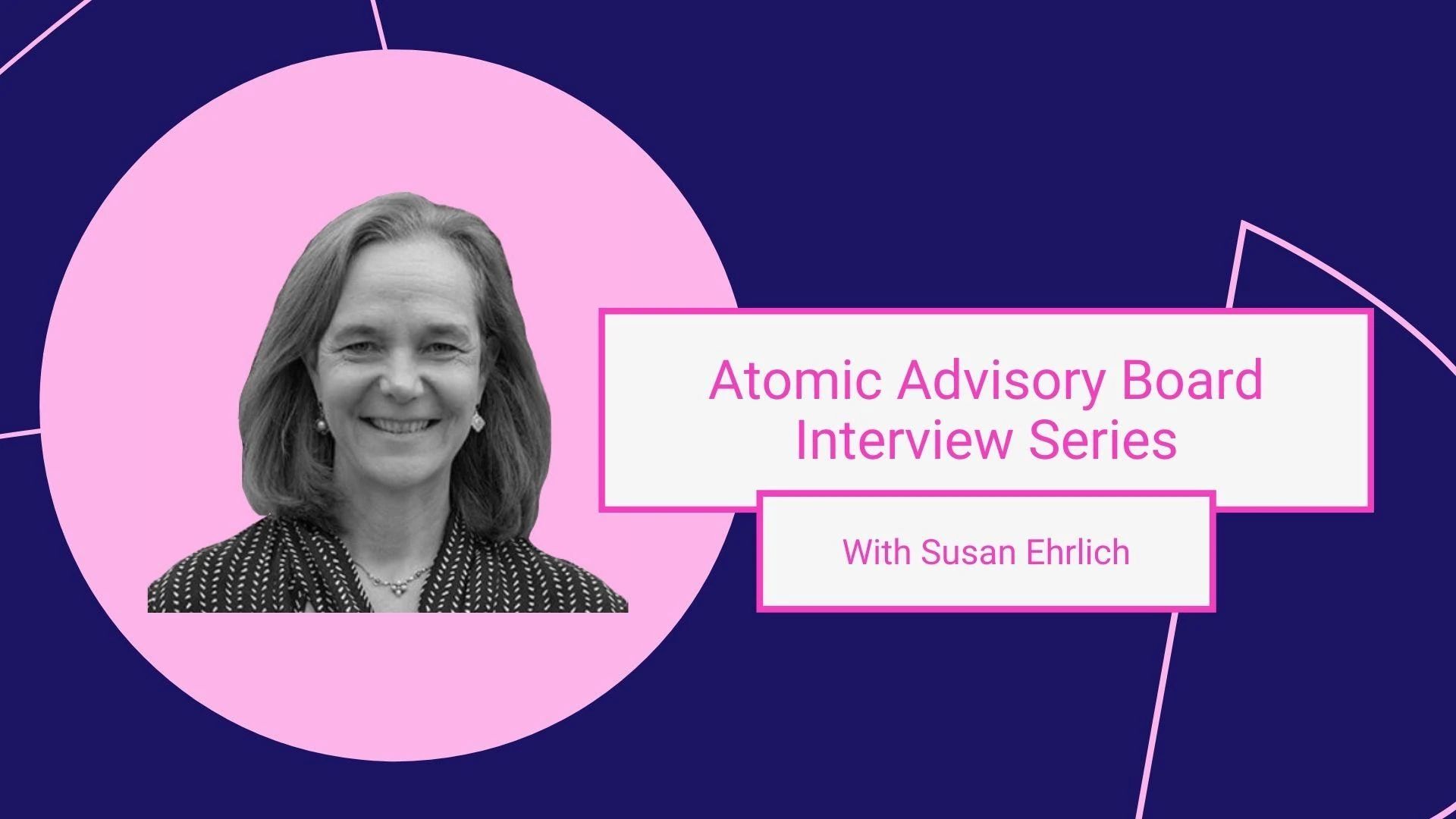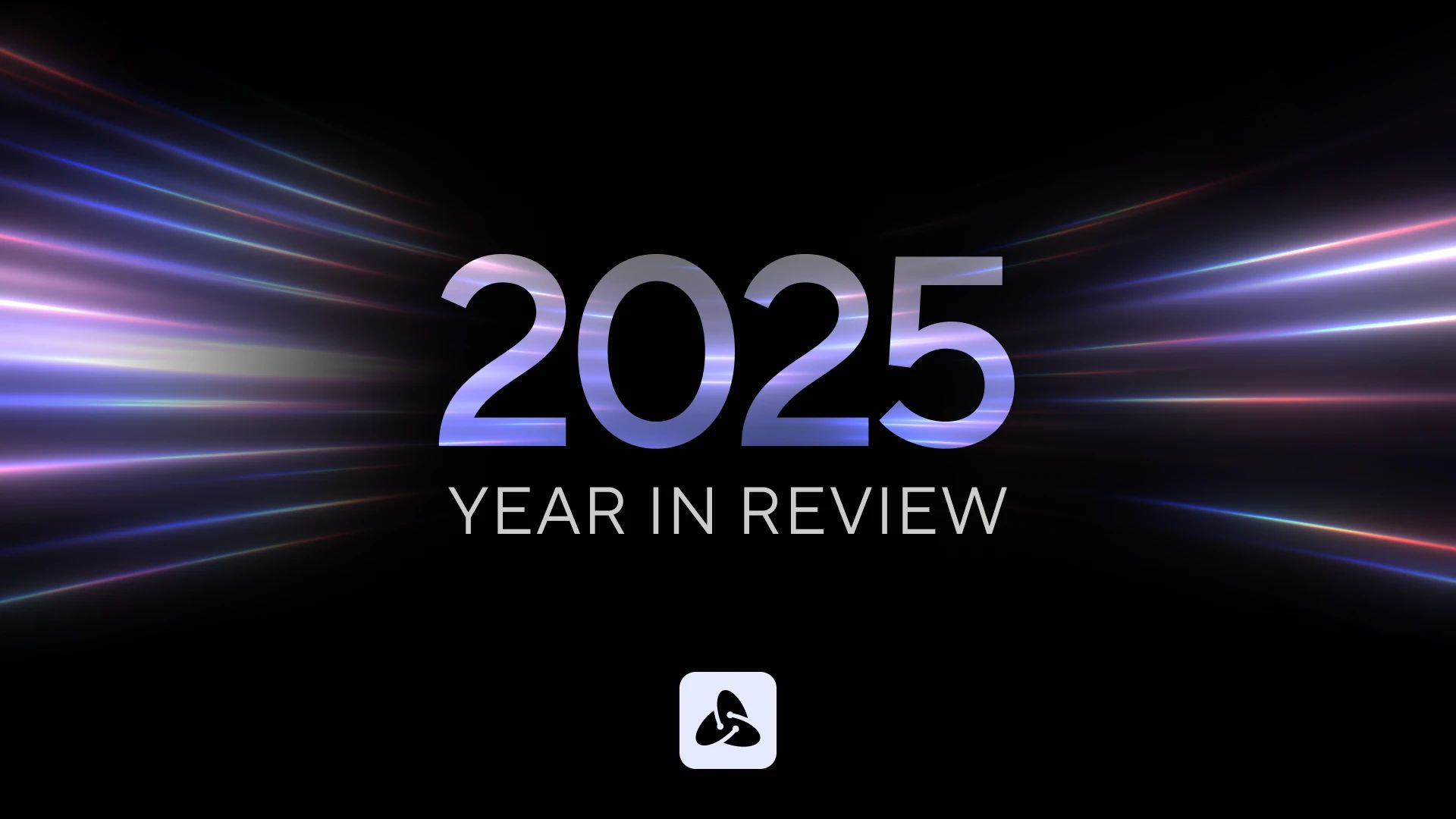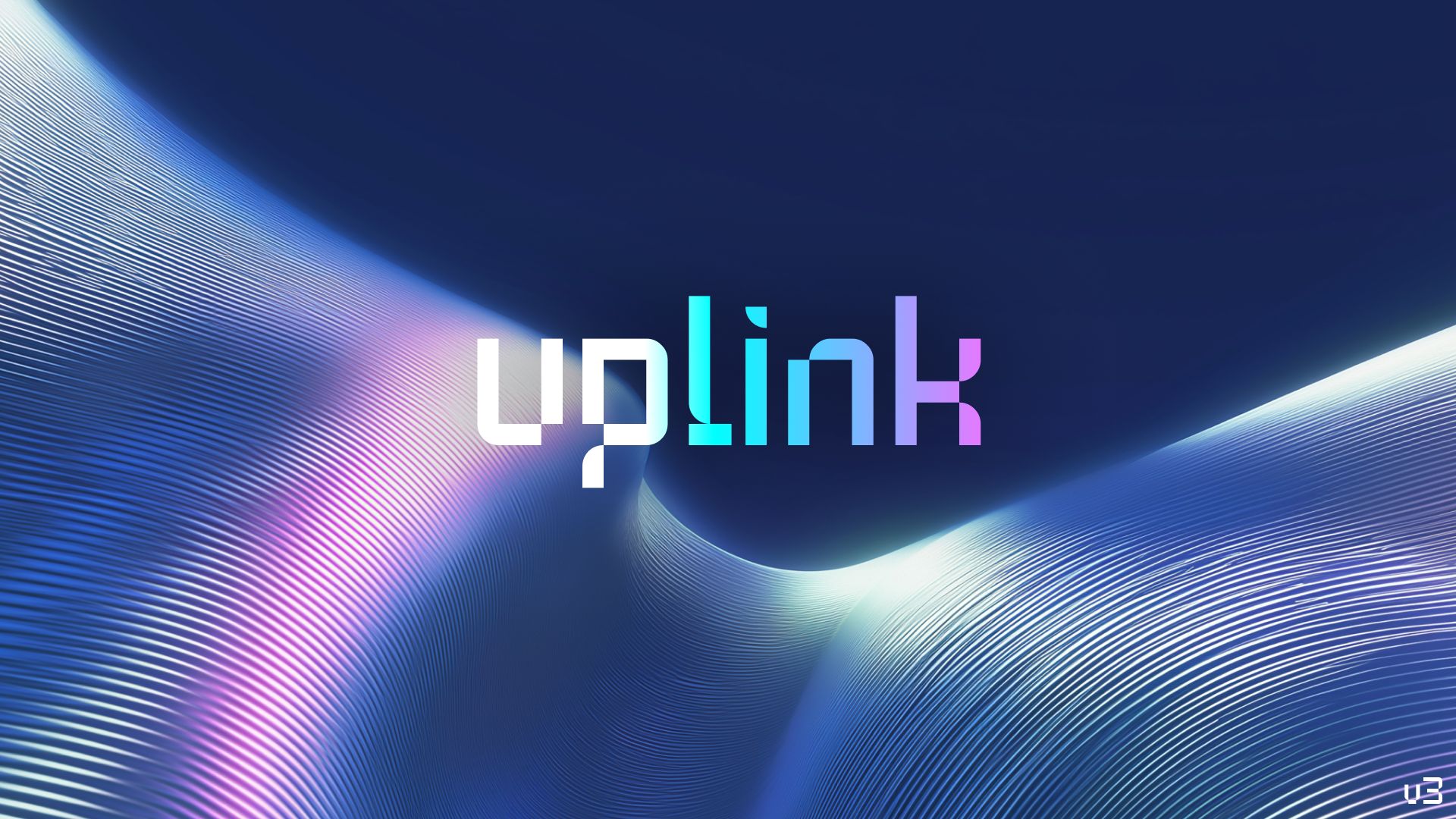How to lead a transitioning culture from a cult of personality into a mission-driven company

Lindsay Davis
Head of Markets

Over the course of her impressive career, Susan Ehrlich has worked in every corner of finance: incumbent banking, neobanking, credit cards, taxes, lending, and online commerce. She’s watched as the entire face of the way consumers interact with money has shifted as the space has evolved with the advent and adoption of innovative technology.
" Since my early career, I’ve observed — and participated in — the accelerated digitalization of cash, credit and financial services. This trend has been happening for years, but the pace of change since the advent of mobile, cloud, APIs and AI has been remarkable! "
Susan Ehrlich
Atomic Advisory Board Members
Ehrlich moved into the fintech space in the last half-decade and has watched with awe as the way consumers experience money has improved through disruption. And she knows the work is far from done: “I can’t think of a single aspect of a consumer’s experience with their money that couldn’t be made better — faster, easier, cheaper, more certain, more transparent and more secure — through the application of technology,” she said.
She joined the board at Atomic because she was struck with the way the company is already solving real issues for consumers, financial service providers, and fintech companies. As an expert in leadership and teambuilding in the financial space, Ehrlich will be an indispensable asset to the Atomic board.
We caught up with Susan Ehrlich, one of Atomic’s Advisory Board Members, to learn more about her journey through the finance space, and how her experience as CEO at Earnest taught her how to turn a cult of personality culture into mission-driven companies.
Q: You’ve had a diverse career that took you across every different sector of finance. Take us through your background and what eventually attracted you to fintech.
I spent the first 10 years of my career at Citibank — I’d call that 10 one-year decisions to stay at Citi. I started on the commercial side of the bank and then I found my way over to the consumer bank and to credit cards. Credit cards were already direct-to-consumer even before the internet — it was largely direct mail and so there was a high degree of analytics, data, and analysis that was already happening in that category of banking. Credit cards were ahead of banking in that regard. Then, when online, email, and mobile started to accelerate changes — it was a really interesting place to have really learned consumer finance and the digitization of that business.
Then I moved to San Francisco to work on the turnaround of Providian’s credit card business. From there, I became really intrigued by the opportunity to leverage retail to deliver financial services more efficiently and at scale. I joined Sears and I led the evolution of Sears Financial Services, and then did the same at H&R Block.
In retail, it’s really about how easy and frictionless you can make the experience of getting the bank product in the client’s hands.
Since you already have the customer in the store, you can take out a big chunk of the cost, which comes in the form of marketing and origination expenses.
As a retailer, you should be able to offer a better value proposition and a lower cost of delivery, because of that efficiency. And that proved to be true.
That idea was the thesis for my shift to Amazon as well. But the move to Amazon turned out to be my introduction to fintech, because that company really is a technology company as you know. Retail just happened to be the original application of what they were doing. But it’s tech.*
Q: When you look at the core pillars of Amazon, what stands out is that the end customer is Amazon’s marketplace of buyers and sellers — that was the origin of AWS and their lending products, among other key forays into financial services.
I did a program called Women on Boards at Harvard Business School around 2017 and Amazon was one of the case studies that they used in the course. The opening question was: “What is Amazon?” I answered that, from my insider’s perspective and as an investor, a client, and a customer:
Amazon is the world’s largest publicly-traded venture capital fund. Ultimately, their product is innovation.
Amazon is the world’s largest publicly-traded venture capital fund. Ultimately, their product is innovation. Look at all of the categories that they disrupt with the application of technology; innovation is the business that they’re in. They just happen to find applications and then go deep and broad on those. The professor didn’t like that answer, but I love it because it explains what makes them different!
Q: You were CFO at Simple and then CEO at Earnest. How did you transition from Amazon over into the more squarely fintech space?
So, I went from the slowest company on the planet at H&R Block to the fastest company on the planet at Amazon. So, at Amazon, I would say I got spun off that wheel, because it was just too much too soon. H&R Block has one busy season — they deliver for six months, and then they plan for six months, and then they deliver for six months and then they plan for six months.
H&R Block is a very consistent day in and day out business, and it doesn’t change a lot. In many ways, it was the antithesis of the Amazon work culture and environment. So, I was only at Amazon for a year and a half, because the culture was just tough for me.
My next job out of Amazon was actually consulting work for LendingClub. I spent nine months at LendingClub working on a new product initiative for them. They had just gone public and had cash in the bank, and were looking to diversify their product set. From there, I got a full-time gig at Simple, so I moved from Seattle down to Portland, and was at Simple for two years.
While I was in Portland, I got a call from a recruiter about the opportunity at Earnest. It meant I could get back to the Bay Area and be on the lending side again — which is where money is made in banking. It also meant I would become the company’s CEO. It was a no brainer, right? If it wasn’t, I wouldn’t have left Simple. There was no reason to leave other than an opportunity that was just too good to turn down.
Q: When you were brought on as CEO of Earnest, the company had just been acquired by Navient which had a terrible net promoter score (NPS) among student borrowers. Additionally, the founders were departing. How were you able to transition the company’s culture during turnover and turnaround consumer’s perceptions?
I was asked one time: “What was the most difficult decision I had to make at Earnest?”
Upon reflection, the answer was the decision to join at all.
So, while the things I mentioned earlier — the location, the opportunity — checked the boxes, I also knew the recruiter forever and trusted that he believed in the opportunity he was bringing me. I knew the company and had met the founders years prior, and I was very intrigued and impressed with what they were doing.
Interestingly, when I interviewed I only talked to Navient’s people. Even when they offered me the roll and I asked about meeting the Earnest team they told me no, and effectively that I would need to accept or decline the offer before meeting anybody at Earnest. I was a bit taken aback, but they explained,
"Well, here’s the problem. If you go in there and meet this team that is shell shocked — after their founder has left, their company has been acquired, and they’ve lost a lot of leaders — and you hate them, and they love you, our problem is worse.
And if you go in there, and you love them, and they hate you, we’re still going to put you in there. And so our problem is worse.
There isn’t a whole lot of advantage that comes from you meeting them before they know you’re the next CEO. We’re gonna need you to basically accept this offer blind."
And so I did.
We talked about the fact that they could all quit tomorrow and then we will be starting again from scratch. I wanted to be clear about the risks. But they said, “No, we understand. We totally get it.” It’s crazy to just say: I don’t know what’s going to happen here but I’ll be really candid and transparent about it, and we’ll try to figure it out.
I did have a lot of transition on the executive team. Most of it was just people leaving for other opportunities. But they stuck around longer than they expected to, and had a good experience. I’m still in touch with most of the execs who left to do other things. I had a lot of the original executive team reach out to offer me advice and input —people care about the company and the mission. So, it was really rewarding to see that and to have the benefit of all of their input as we were trying to figure out what to do.
Q: So much of the romance in Startup Land is about the founder and the lightning bolt idea. What do you think is the most underrated part of that second job that you’re talking about?
Q: How challenging is it to come in as a CEO who has to rework the company, rebuild the team, and hold onto the original mission, all while being able to pivot?
The first challenge is that you no longer have the cult of personality. In the case of Earnest, Louis Beryl and Ben Hutchinson created a company and found product-market fit pretty quickly. It’s a business that went through a lot of tumult and transition, but the one thing we continue to do is generate business, grow cash flow, and build profit. Fundamentally, a company needs product-market fit — otherwise, the rest of it is just not worth the time or the effort. And those guys definitely found that, but they weren’t as successful at building a company. So, there was really nothing but product-market fit to work when I got there, and so I had to get people reoriented to the mission.
What I chose to do was not rebuild a cult of founders. Instead, we shifted to being about the mission and about our clients.
We had a lot of people who were not interested in that, which meant turnover was super high, but we had to make Earnest much more mission-oriented and much more values-oriented while remaining in pursuit of an ambitious vision for the company. So, we pivoted to a refreshed mission and vision: We believe in a world where it takes less time to pay for your education than to earn your degree. Experimentation was all in pursuit of that. What other parts of the journey to choosing your education would help make your choices about how to pay for it more economic? Shifting to the advisory stage on such as, selecting a school, paying for tuition, taking advantage of scholarships and grants to reduce out-of-pocket expenses. Post-graduation, how to help students consolidate and repay loans.
If take a wholistic view of a student’s journey, from applying to accepting, to graduation and paying off loans, there are stills lots of opportunities to fix a fundamentally broken system.
Student debt does not work for anybody, and it’s gotten worse; there’s currently $1.7 trillion owed by borrowers. You’ve previously talked about helping students in advance by making the universities have skin in the game.
Q: What are some interesting models you’ve seen or thought about to help solve the student-debt crisis?
I have two strongly held beliefs on student debt. The first is that there isn’t a student-debt problem; there’s actually a graduation-rate problem. Because what we learned in the data at Earnest is if you’ve graduated with a degree, and you’ve got a job, you pay off your student loans. The problem: only six out of 10 students who start a bachelor’s degree graduate.
So, 40% of the population is going to drop out and the default rate amongst borrowers who don’t complete their degree is three times higher than for those who earned a diploma.
The amount of debt outstanding in that population is less than $10,000. So, it isn’t the amount of student debt; it’s the fact that these former students have this debt, and there is no improvement in their earning potential that occurred whatsoever. That, to me, is the problem.
The second of my strongly held beliefs is that there has been an unconscionable risk shift that we have allowed to happen in this country. Why should those who didn’t get the benefit of the degree be the ones footing the bill for the school?
I come from a retail background, and in retail, there was a brand promise that Sears has made for over 100 years, which is: satisfaction guaranteed or your money back. That is a promise that these universities should make on behalf of the students who drop out without their degree. The school should have some skin in the game for paying back that debt or helping them get out of it. Because it’s the schools that put them in debt and then didn’t deliver on the promise to give them the education. The fact that we’ve shifted the risk to the students is a terrible system. Hopefully, we will open our eyes to a fundamental problem, which is that universities are not accountable for student outcomes. That’s a terrible system!
Q: Are there any books that you recommend to leaders in the fintech space?
I have a handful of books that are all piled up right next to my monitor over here, because I pull them out and use them often. Two are by Patrick Lencioni, a consultant with The Table Group here in the Bay Area. He wrote two of my favorite books: The Ideal Team Player and The Advantage.
We applied the lessons of The Ideal Team Player at Earnest, including making executive team changes in order to improve the chemistry of the executive team. It was astounding to see the impact that removing even a single person on the team can have on team performance, to the point where I think everybody should either live that experience or just accept that that experience is true.
In his followup book, The Advantage, Lencioni really helps you think about and frame the reason your company exists, and how to talk about your company in a really concise way.
The other book that is a go-to is The First 90 Days. I think I’ve helped make that book a bestseller! I recommend it any time I’ve ever done a transition and to any team member that’s been promoted or moved to a new role. During onboarding at Earnest, everybody now gets a copy of it. My own copy is incredibly dog-eared, because I swear I’ve probably read it over a dozen times cover-to-cover.
Q: You talked about coming in at Earnest and navigating the shift from a cult of personality to a mission-driven company. Do you have any tips for a founder or a CEO on how to shift the company towards a mission-driven focus?
I do. Someday, I may even write a book.
First, we had to do a lot of work as a leadership team, because the shift from a cult of personality to a first-team mentality is a substantial one.
The company we wanted needed to be led by a team that is cohesive, and works collaboratively together and cannot be politically divided. Once a company understands that politics and divisiveness are going to be unacceptable and there’s going to be an insistence on collaboration and working cohesively together, a new culture can start to thrive.
The cult of personality of the founders stops that nonsense because everybody knows the buck stops with those guys. But once they’re gone, you need to replace that with some healthier way.
We did that with a lot of team development and a lot of work building a cohesive first team. As Patrick Lencioni outlines in The Advantage, the first team needs to decide and explain: what is the thesis? What is the vision? Why does the company exist? What are the values that you’re going to hold and how are you going to evidence them in the way that you work? What’s the most important thing that you’re doing right now? The leadership team needs to be focused and needs to answer those questions in the same way.
Q: That team needs to be able to make tradeoffs between what’s important to them personally and what’s important to the company. That First-Team Mentality needs to be taught, and we built systems which helped make it possible for Earnest to work through this transition from founder-led to mission-led.
As I said, there was a lot of turnover. A lot of people were not signed up to be on a mission. There was close to a 50% turnover in the management ranks. But we did change hearts and minds too.
My two experiences at Simple and Earnest were such an awesome compliment to one another. At Simple, we had so much difficulty finding product-market fit, but those of us in support functions had built a really good company. We even offered up the structures to other BBVA startups: we did their people team support, we did their finance team support, we were the infrastructure on which they could build their company. Because we were still struggling with product-market fit, you have all these people in these functions perfecting their craft while we were waiting for revenue. At Earnest, it was the complete opposite. None of that infrastructure was in place. Yet, you had product-market fit, you’re producing cash, and it’s a success.
Now, I know what I’ve got to go build. We’re just gonna have to build the infrastructure to be a company. The good news is we’re in an area where we’ve found a gusher. So, we’re in a good place to figure this stuff out.
As a result of our team’s work at Earnest, the company is now #2 in the category of Refi and growing its role as a student lender. It should grow to become about 10% of Navient’s bottom line this year, and it’s been cashflow positive for two years. It’s in a really strong place right now and will continue to become a bigger and bigger part of the space.
Who is next in Atomic’s Advisory Board Interview Series?
Hint: He’s one Smarty-pants when it comes to getting to the core of fintech and we’ll reveal who next week.


